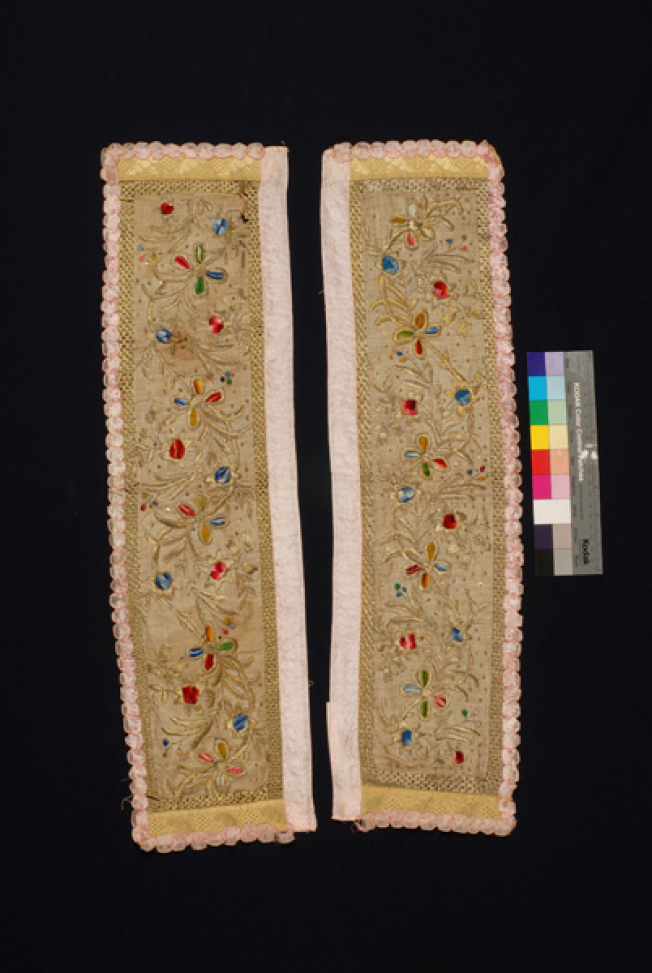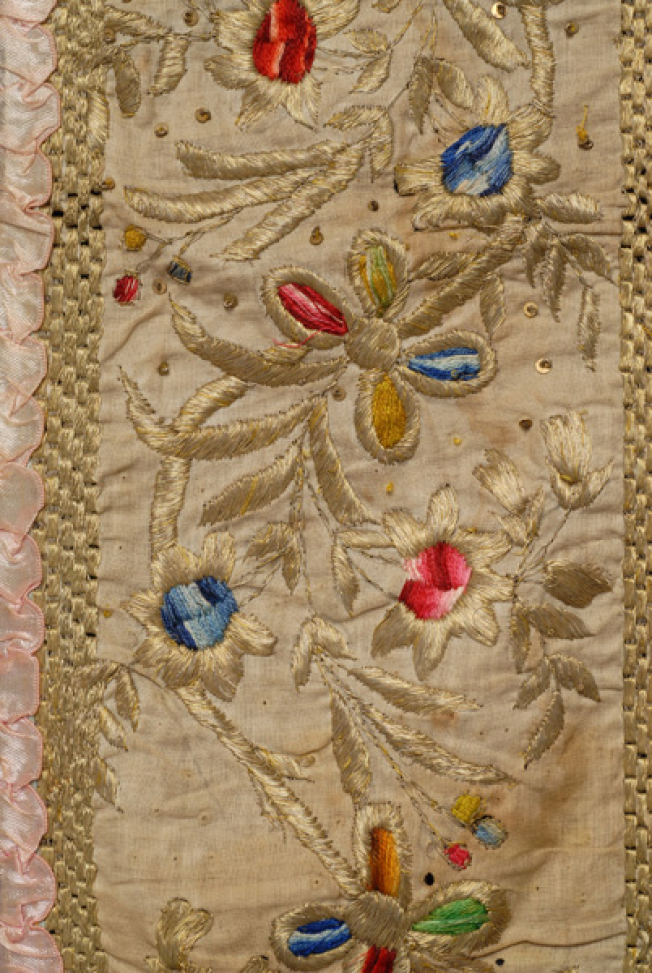embroidered band
14358,α-β
Object Identity
Object ID Number
14358,α-β
Object name
embroidered band
Production date range
beginning of 20th century
Part of outfit
No
Physical Description
Description
Παραλληλόγραμμο κομμάτι από βατίστα (βαμβακερό ύφασμα), κεντημένο με χρυσοκλωστή και πολύχρωμα μετάξια. Πιθανολογώ ότι το συγκεκριμένο κέντημα αποτελεί το επίρραπτο κέντημα που ενώνεται στις άκρες της νυφικής μπόλιας (σκέπη) της γυναικείας φορεσιάς της Σαλαμίνας. Στις δύο άκρες του φέρει επίρραπτη διακόσμηση με κομμάτι χρυσής τρέσας και στο σημείο της ένωσης του με το μεταξωτό ύφασμα της μπόλιας, μεταξωτή ροζ κορδέλα του μέτρου. Σύμφωνα με τη βιβλιογραφία, τα κεντήματα που προσραβόταν στις άκρες της σκέπης τα προμηθεύονταν από τα εμπορικά της Σαλαμίνας ή του Πειραιά ή τα κεντούσαν οι γυναίκες. Κάτω από αυτά προστίθενταν και στερεώνονταν τα κρόσσια, κομμάτι φαρδιάς χρυσής δαντέλας με χρυσές πούλιες στην άκρη. Η τεχνική του κεντήματος είναι γραφτή, με ανεβατή βελονιά. Ένα χρυσοκέντητο ανθοφόρο κλαδόσχημο μοτίβο
αναπτύσσεται σε όλη την επιφάνεια του βαμβακερού υφάσματος. Το περίγραμμα των λουλουδιών γίνεται με χρυσοκλωστή και το γέμισμα τους με πολύχρωμες μεταξοκλωστές (ροζ, φούξια, κόκκινες, μπλε, σιελ, πράσινες, κίτρινες, λαδιές και καφέ). Διάσπαρτες πούλιες στερεωμένες με τιρ-τιρ συμπληρώνουν το διάκοσμο. Τέλος, χρυσοκέντητη ψαθωτή διακόσμηση πλαισιώνει το ολάνθιστο φυτικό μοτίβο.
Decoration & Patterns
Decoration
vegetal decoration
Decorative patterns / subjects
flowers
Width
0.180
Length
0.650
Production
Production date range
beginning of 20th century
Production place (Country | Geographic Area | Prefecture & Region)
Greece |
Central Greece |
Attica
-
Material
brailed gold fillet
cotton
gold thread
silk ribbon
silk thread
spangles
tir-tir (lustring)
Techniques
applique
industrially woven textile
traced design embroidery,
double-darning stitch
Use
User
woman
Purpose
Embroidery which is joined on the edge of a silk bolia. The joint of the embroidery with bolia is covered by pink ribbon sold by the meter.
Date range
beginning of 20th century
Place of use (Country | Geographic Area | Prefecture & Region)
Greece |
Central Greece |
Attica
Salamis
Acquisition
Acquisition method
Untraced Find
Documentation
Research bibliographic references
Image license
Use the file or the thumbnail of the image according to the license:
CC BY-NC-ND 4.0
Attribution-NonCommercial-NoDerivatives










